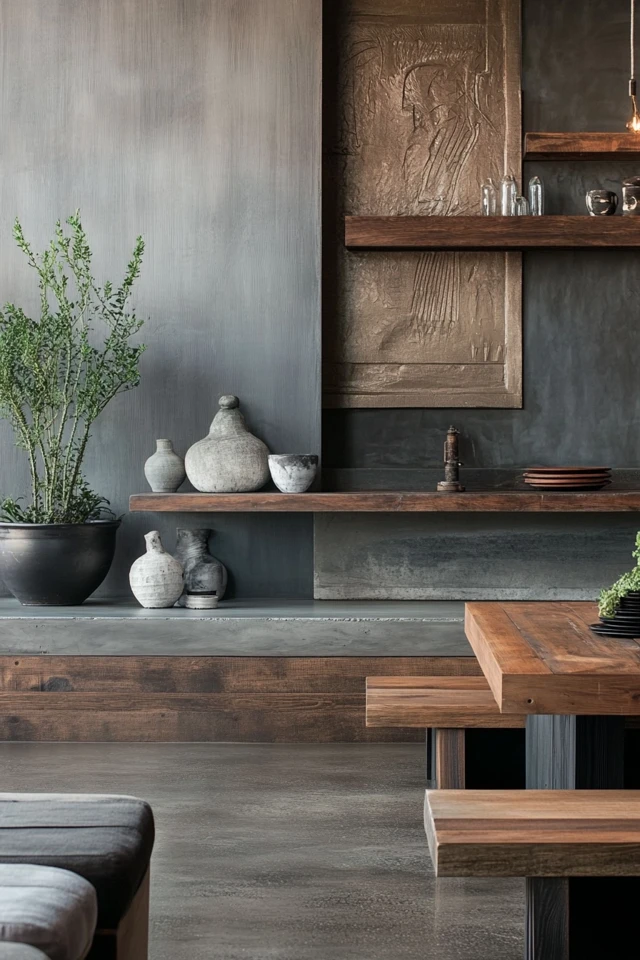Introduction
Concrete and wood are two materials that couldn’t be more different: one is cold, sleek, and modern, while the other is warm, textured, and timeless. Yet, when paired together, they create an exceptional balance of contrasts that’s perfect for achieving industrial harmony in your home. Whether in furniture, flooring, or decor, the combination of concrete and wood adds depth, texture, and character to industrial spaces. It bridges the gap between the raw, utilitarian aesthetic of concrete and the cozy, organic feel of wood.
I fell in love with this pairing during a kitchen renovation project. I had a polished concrete countertop installed but felt the space needed some warmth to balance its stark modernity. Adding reclaimed wood open shelving and a natural wood island base transformed the room. Suddenly, the space felt grounded yet dynamic, rugged yet inviting. It was the perfect mix of industrial edge and natural warmth.
If you’re looking to create industrial harmony in your home, this guide will show you how to blend concrete and wood in furniture, surfaces, and decor for a stunning and balanced design.
The Perfect Design for You
Concrete and wood are ideal for anyone who appreciates the raw, minimalistic beauty of industrial interiors but wants to soften the edges with natural textures. This design approach works particularly well in lofts, modern homes, and any space with open layouts and high ceilings.
By combining these two materials, you can achieve a timeless look that’s both bold and inviting. Whether you’re designing a kitchen, living room, or outdoor space, concrete and wood create a cohesive design language that celebrates both function and form.
Picture Gallery

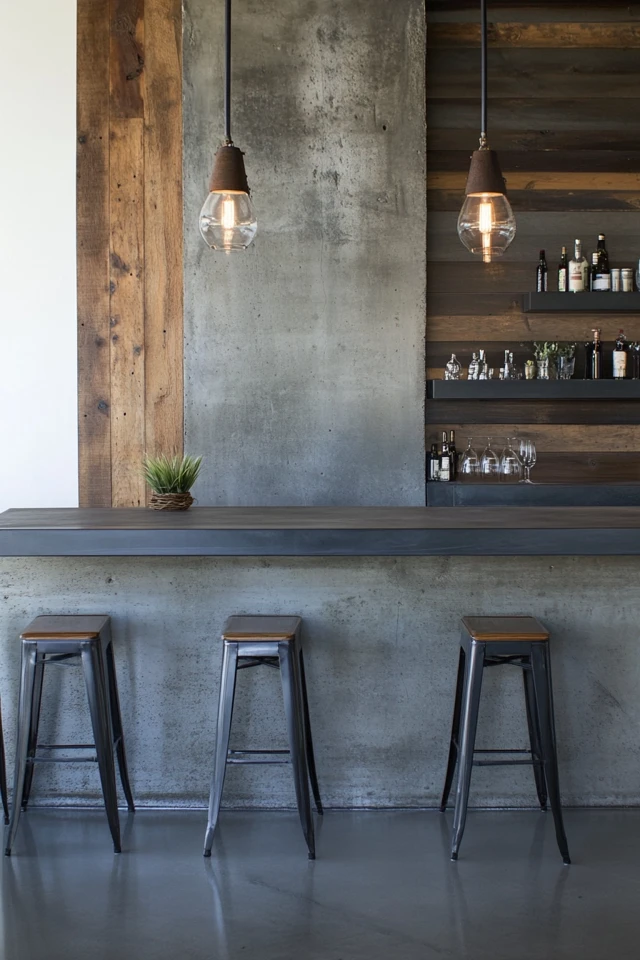
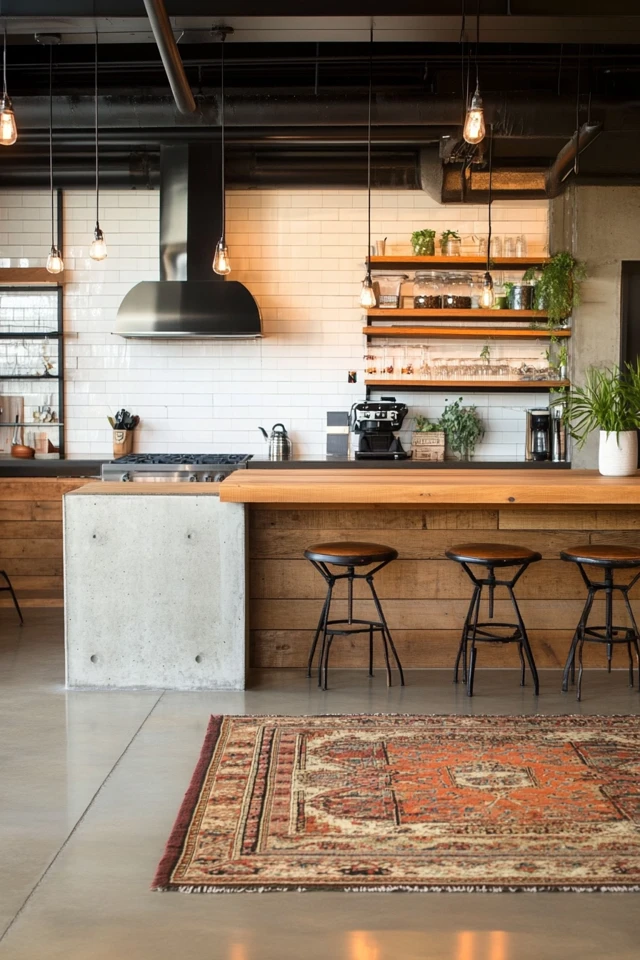
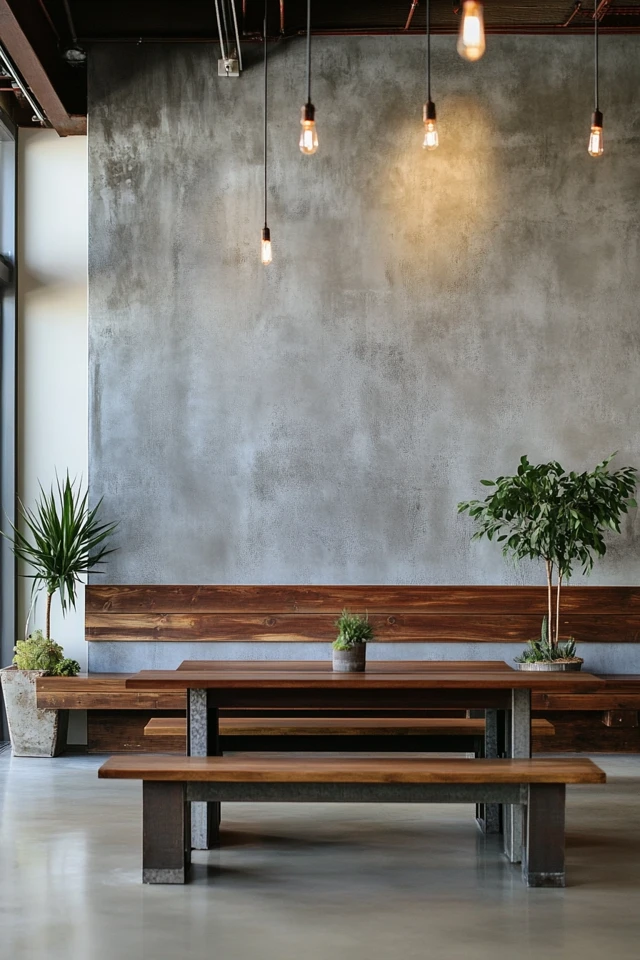
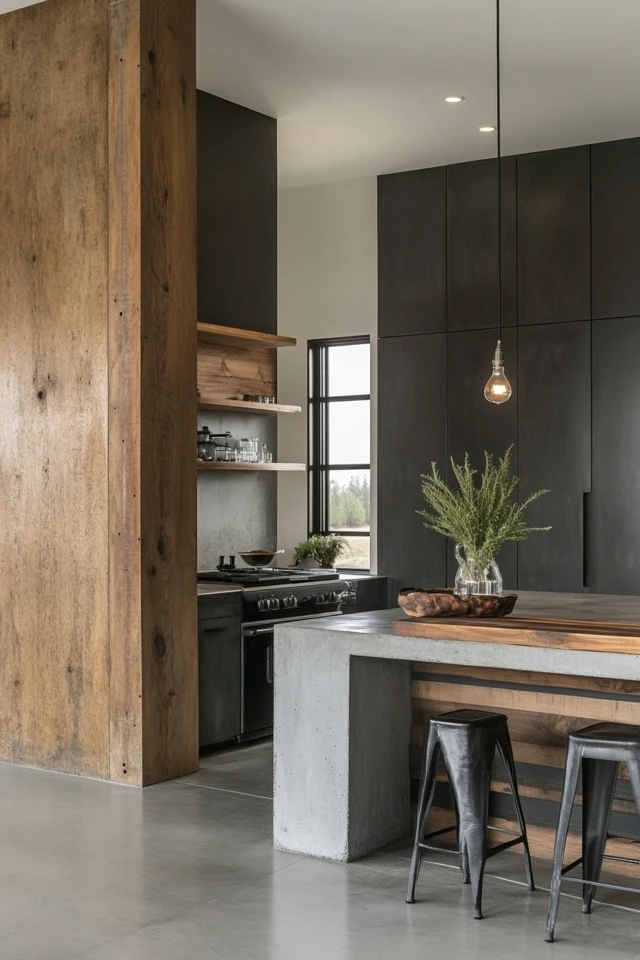
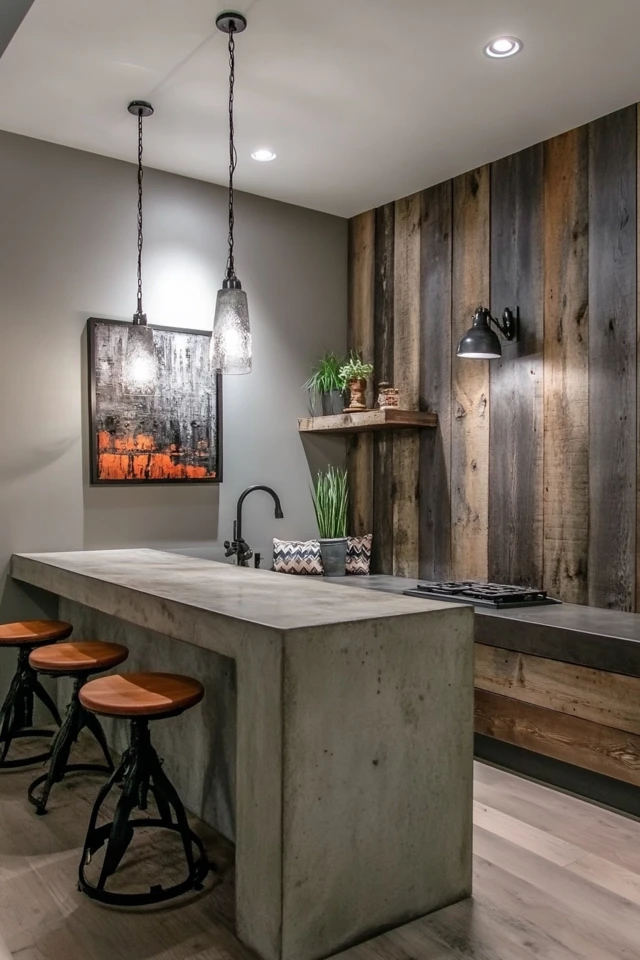
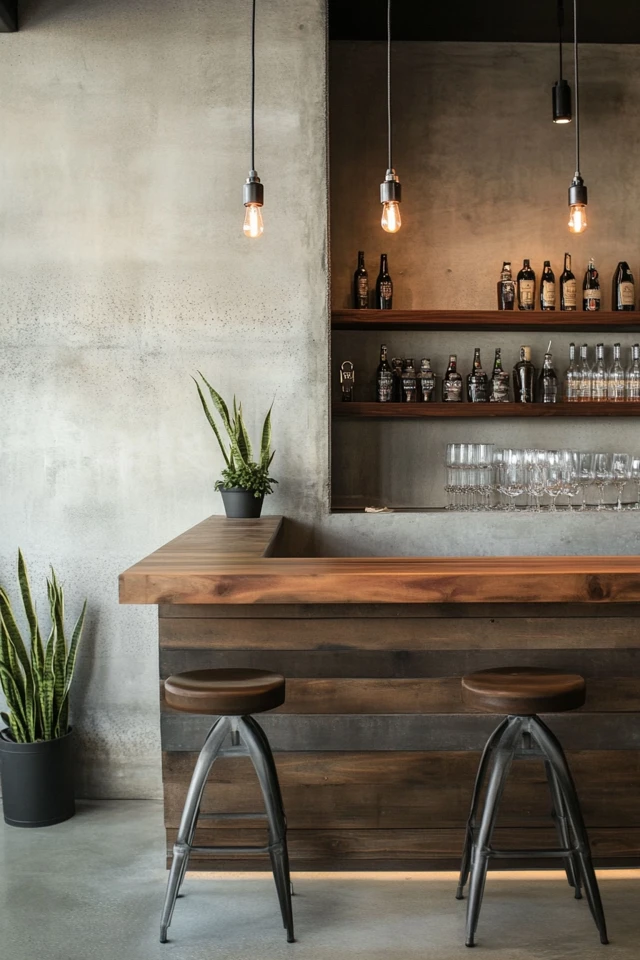
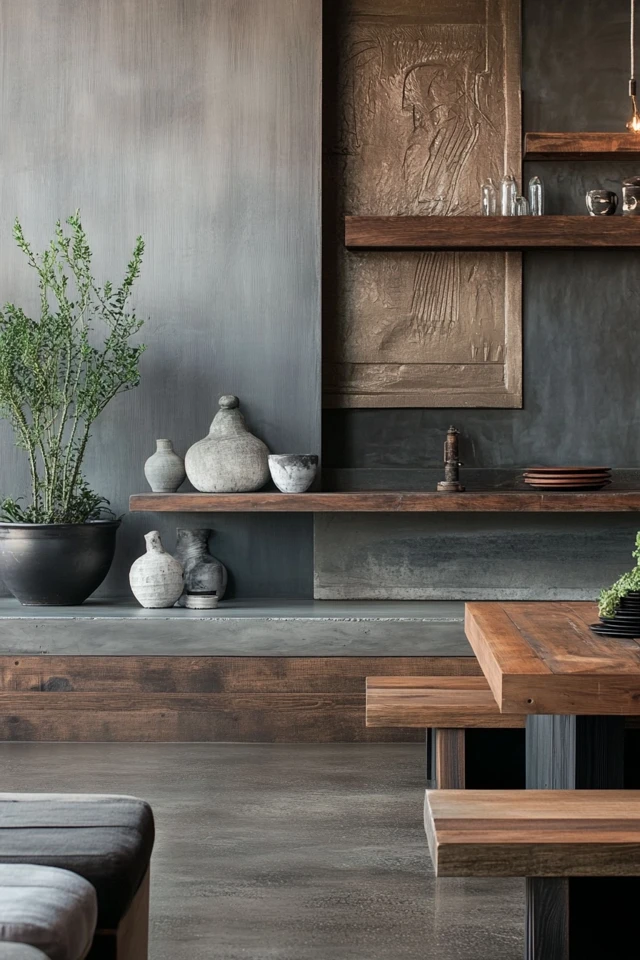
Why These Key Elements Work So Well Together
Concrete and wood create industrial harmony because they complement each other’s strengths and counterbalance their weaknesses. Here’s why this pairing works so beautifully:
- Contrast in Texture:
- The smooth, cool surface of concrete contrasts beautifully with the grain and warmth of wood, creating visual interest.
- Balancing Warmth and Coolness:
- Wood introduces warmth and organic appeal to balance the cold, industrial feel of concrete.
- Durability and Longevity:
- Both materials are highly durable, ensuring your design stands the test of time.
- Versatile Aesthetic:
- Together, they suit various design styles, from rustic industrial to modern minimalism.
- Natural Connection:
- Concrete’s stone-like quality and wood’s organic roots evoke a connection to nature, grounding the space.
- Neutral Palette:
- Both materials feature neutral tones, allowing them to blend seamlessly with other design elements.
When combined thoughtfully, concrete and wood create a harmonious balance that brings depth and character to any room.
How to Use Concrete and Wood for Industrial Harmony: Step-by-Step
1. Start with a Concrete Base
- Incorporate concrete as a foundation material, such as floors, countertops, or walls.
- Choose polished concrete for a sleek look or textured concrete for a raw, unfinished aesthetic.
2. Add Wooden Accents
- Use wood to soften the space by introducing furniture, shelving, or cabinetry.
- Opt for natural or reclaimed wood for an authentic, industrial vibe.
3. Create Layers
- Layer wood and concrete elements to add depth and visual interest. For example, pair a concrete dining table with wooden chairs or a concrete fireplace with a wood mantel.
4. Combine in Furniture Design
- Look for pieces that integrate both materials, such as a coffee table with a concrete top and wooden legs.
- This ensures a cohesive look and brings both textures into a single focal point.
5. Incorporate Greenery
- Add plants to soften the rawness of concrete and enhance the organic appeal of wood.
- Use wooden planters or concrete pots for a cohesive design.
6. Balance the Color Palette
- Stick to neutral tones for a classic industrial look, or introduce muted greens, blues, or warm metallics to add depth.
7. Use Lighting Strategically
- Highlight the textures of both materials with industrial-style lighting, such as pendant lights or sconces.
8. Blend Indoor and Outdoor Spaces
- Extend the pairing of concrete and wood to outdoor areas by using concrete pavers with wooden decking or benches.
9. Incorporate Textiles
- Add soft furnishings like rugs or cushions to complement the hardness of concrete and wood while creating a more inviting space.
10. Experiment with Scale and Proportions
- Play with the size of concrete and wood elements, such as combining large concrete surfaces with smaller wooden details for balance.
10 Creative Applications for Concrete and Wood
1. Concrete Countertops with Wooden Cabinets
- Pair sleek concrete countertops with natural or stained wooden cabinetry for a warm, modern kitchen.
2. Wooden Floors with Concrete Walls
- Use wooden floors to add warmth and contrast to industrial concrete walls.
3. Concrete Dining Tables with Wooden Chairs
- Create a stunning dining area by pairing a concrete table with rustic wooden chairs or benches.
4. Reclaimed Wood Shelving with Concrete Backsplash
- Add floating wooden shelves against a concrete backsplash for a functional and stylish kitchen.
5. Concrete Sinks with Wooden Vanities
- Combine concrete vessel sinks with wood vanities for a striking bathroom design.
6. Wood Beams with Concrete Floors
- Use exposed wooden beams to add architectural interest and warmth to spaces with polished concrete floors.
7. Outdoor Firepits with Wooden Seating
- Pair a concrete firepit with wooden benches or Adirondack chairs for a cozy outdoor setup.
8. Concrete Planters with Wooden Decking
- Use large concrete planters alongside wooden decking to create a seamless indoor-outdoor transition.
9. Staircases with Concrete Steps and Wooden Railings
- Combine concrete stair treads with wooden handrails for a modern, industrial look.
10. Concrete Accent Walls with Wooden Furniture
- Add a statement concrete wall as a backdrop for a wooden bed frame, sideboard, or desk.
FAQ Section
1. Are concrete and wood suitable for small spaces?
Yes! The combination works well in small spaces, as wood adds warmth and prevents concrete from feeling too cold or overwhelming.
2. How do I maintain concrete and wood surfaces?
Seal concrete to prevent staining and clean with mild soap and water. For wood, use wood polish or oil to maintain its finish and prevent drying.
3. Can I use concrete and wood in humid areas?
Yes, but make sure to seal both materials properly. Use treated wood and moisture-resistant concrete in areas like bathrooms.
4. Do concrete and wood work with other materials?
Absolutely! These materials pair well with metal, glass, and textiles for a layered, industrial look.
5. Can I DIY concrete and wood projects?
Yes! Projects like concrete tabletops, planters, and wooden shelves are popular DIY choices for industrial-inspired spaces.
Variations
- Modern Minimalist
- Use polished concrete and light, natural wood for a clean, minimalist aesthetic.
- Rustic Industrial
- Incorporate reclaimed wood with textured or weathered concrete for a cozy, rustic vibe.
- Eco-Friendly Design
- Use sustainable materials like recycled concrete and FSC-certified wood for an environmentally conscious approach.
- Urban Contemporary
- Combine sleek concrete surfaces with dark-stained wood and metal accents for a chic, urban look.
- Scandinavian Industrial
- Pair light concrete with blonde wood and soft textiles for a Nordic-inspired design.
How to Showcase It
- Living Rooms: Use a concrete coffee table with wooden legs or a wood TV console against a concrete accent wall.
- Kitchens: Pair concrete countertops with wooden open shelving for a clean and functional look.
- Bathrooms: Use a concrete sink basin with a wooden vanity for a spa-like feel.
- Outdoor Areas: Combine concrete pavers with wooden benches or pergolas to create a modern patio.
- Dining Areas: Feature a concrete dining table with wooden chairs for a striking centerpiece.
Occasions to Feature It
- Renovations: Update your home with modern, industrial elements by combining concrete and wood.
- Open-Concept Layouts: Use these materials to define spaces while maintaining a cohesive aesthetic.
- Outdoor Living: Blend concrete and wood for stylish patios, decks, and garden areas.
- Eco-Friendly Projects: Incorporate sustainable concrete and reclaimed wood for a green design approach.
- Loft Living: Embrace the industrial charm of concrete and wood in open-plan lofts.
Conclusion
Concrete and wood are the ultimate duo for achieving industrial harmony. Their contrasting textures and tones create a balanced aesthetic that’s both bold and inviting, making them perfect for any space. From kitchens and bathrooms to living rooms and outdoor areas, the possibilities are endless.
Ready to transform your space? Start with a simple project, like a concrete and wood table or accent wall, and let your creativity flow. Share your results, inspire others, and enjoy the timeless appeal of industrial harmony. Here’s to creating a home that’s as functional as it is beautiful!

